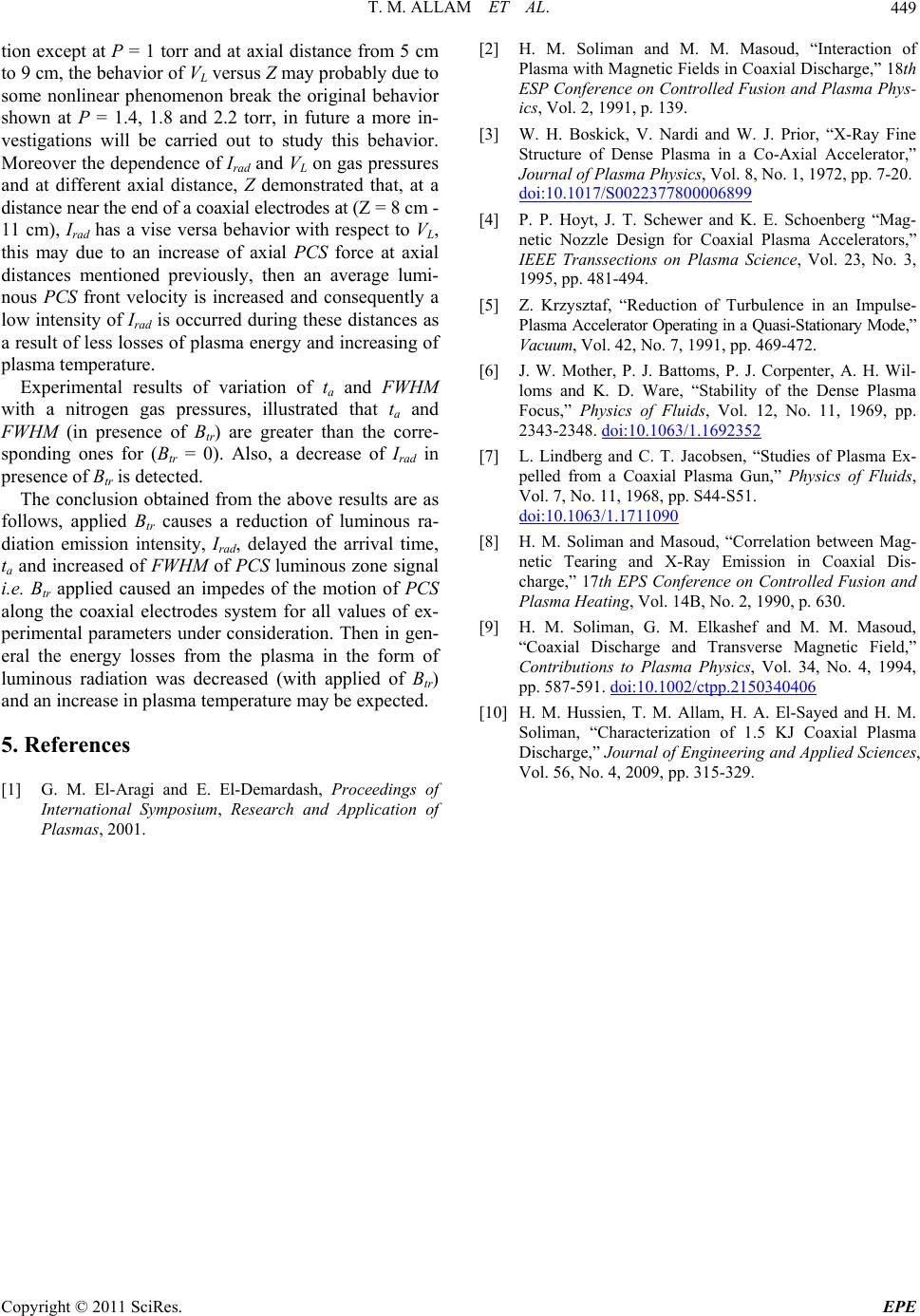
T. M. ALLAM ET AL.
Copyright © 2011 SciRes. EPE
449
tion except at P = 1 torr and at axial distance from 5 cm
to 9 cm, the behavior of VL versus Z may probably due to
some nonlinear phenomenon break the original behavior
shown at P = 1.4, 1.8 and 2.2 torr, in future a more in-
vestigations will be carried out to study this behavior.
Moreover the dependence of Irad and VL on gas pressures
and at different axial distance, Z demonstrated that, at a
distance near the end of a coaxial electrodes at (Z = 8 cm -
11 cm), Irad has a vise versa behavior with respect to VL,
this may due to an increase of axial PCS force at axial
distances mentioned previously, then an average lumi-
nous PCS front velocity is increased and consequently a
low intensity of Irad is occurred during these distances as
a result of less losses of plasma energy and increasing of
plasma temperature.
Experimental results of variation of ta and FWHM
with a nitrogen gas pressures, illustrated that ta and
FWHM (in presence of Btr) are greater than the corre-
sponding ones for (Btr = 0). Also, a decrease of Irad in
presence of Btr is detected.
The conclusion obtained from the above results are as
follows, applied Btr causes a reduction of luminous ra-
diation emission intensity, Irad, delayed the arrival time,
ta and increased of FWHM of PCS luminous zone signal
i.e. Btr applied caused an impedes of the motion of PCS
along the coaxial electrodes system for all values of ex-
perimental parameters under consideration. Then in gen-
eral the energy losses from the plasma in the form of
luminous radiation was decreased (with applied of Btr)
and an increase in plasma temperature may be expected.
5. References
[1] G. M. El-Aragi and E. El-Demardash, Proceedings of
International Symposium, Research and Application of
Plasmas, 2001.
[2] H. M. Soliman and M. M. Masoud, “Interaction of
Plasma with Magnetic Fields in Coaxial Discharge,” 18th
ESP Conference on Controlled Fusion and Plasma Phys-
ics, Vol. 2, 1991, p. 139.
[3] W. H. Boskick, V. Nardi and W. J. Prior, “X-Ray Fine
Structure of Dense Plasma in a Co-Axial Accelerator,”
Journal of Plasma Physics, Vol. 8, No. 1, 1972, pp. 7-20.
doi:10.1017/S0022377800006899
[4] P. P. Hoyt, J. T. Schewer and K. E. Schoenberg “Mag-
netic Nozzle Design for Coaxial Plasma Accelerators,”
IEEE Transsections on Plasma Science, Vol. 23, No. 3,
1995, pp. 481-494.
[5] Z. Krzysztaf, “Reduction of Turbulence in an Impulse-
Plasma Accelerator Operating in a Quasi-Stationary Mode,”
Vacuum, Vol. 42, No. 7, 1991, pp. 469-472.
[6] J. W. Mother, P. J. Battoms, P. J. Corpenter, A. H. Wil-
loms and K. D. Ware, “Stability of the Dense Plasma
Focus,” Physics of Fluids, Vol. 12, No. 11, 1969, pp.
2343-2348. doi:10.1063/1.1692352
[7] L. Lindberg and C. T. Jacobsen, “Studies of Plasma Ex-
pelled from a Coaxial Plasma Gun,” Physics of Fluids,
Vol. 7, No. 11, 1968, pp. S44-S51.
doi:10.1063/1.1711090
[8] H. M. Soliman and Masoud, “Correlation between Mag-
netic Tearing and X-Ray Emission in Coaxial Dis-
charge,” 17th EPS Conference on Controlled Fusion and
Plasma Heating, Vol. 14B, No. 2, 1990, p. 630.
[9] H. M. Soliman, G. M. Elkashef and M. M. Masoud,
“Coaxial Discharge and Transverse Magnetic Field,”
Contributions to Plasma Physics, Vol. 34, No. 4, 1994,
pp. 587-591. doi:10.1002/ctpp.2150340406
[10] H. M. Hussien, T. M. Allam, H. A. El-Sayed and H. M.
Soliman, “Characterization of 1.5 KJ Coaxial Plasma
Discharge,” Journal of Engineering and Applied Sciences,
Vol. 56, No. 4, 2009, pp. 315-329.